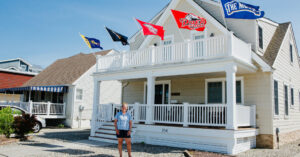A Botanic Garden Determined to Bring Back American Chestnut and Heirloom Apple Trees

“Explore what’s in bloom now,” exclaims a banner on the New England Botanic Garden at Tower Hill’s website. And, indeed, there is much to see.
The dramatic property in Boylston, Mass., includes two conservatories and 18 distinct gardens, both formal and naturalistic. The grounds offer sweeping views across the vast Wachusett Reservoir, as well as hiking trails that tuck into wilder portions of the garden’s nearly 200 acres.
As director of horticulture, Mark Richardson is always attuned to the calendar of displays that his team provides to delight more than 225,000 visitors a year. But the garden has two additional compelling botanical projects — the planting of blight-resistant American chestnuts and the restoration of a historic apple collection lost to disease — that don’t show off in the same way. At least, not yet.
These projects go comparatively unnoticed next to the rainbow border in the Garden of Inspiration area, orchestrated to bloom all season in a progression of hues, or the living walls of colorful, textural plants in an area called the Court.
But the chestnuts and apples are like homecomings — if understated at present — with major celebratory moments anticipated down the road. Those who work with plants must often take the long view.
Sometimes it’s a very long view, Mr. Richardson knows — with the chestnuts, in particular.
“When you operate a botanic garden, you hope that it’s here in perpetuity,” he said, and you work with that horizon in mind, not just the current year’s displays. “You expect that this property, that this garden is going to survive long past anyone who’s actively managing it.”
Both the chestnut and apple trees have significant history on this piece of land, which, in 1986, became the headquarters of the Worcester County Horticultural Society, one of the nation’s oldest horticultural organizations. The apples honor the society’s long agricultural heritage; the chestnuts embody a goal outlined in 2020 in the botanic garden’s strategic plan, calling for using the land for conservation research.
The apple collection, which includes heirloom varieties as old as the 16th century, once welcomed visitors as they ascended the curving driveway. Each fall, at harvest time, the trees were the focus of a popular apple festival.
This was not the collection’s first home. It was begun by a former horticultural society trustee during the Depression era, and then lived for a time at nearby Old Sturbridge Village before becoming part of the botanic garden.
But the orchard’s latest incarnation had to be cut down in November 2019 because of fire blight, a disease caused by a naturally occurring bacterium that was once more manageable in the Northeast, and more of a summertime issue.
“It’s really a climate-change story,” Mr. Richardson said, because more frequent warm and wet spring weather has triggered epidemics of the bacterium that could no longer be kept in check.
Where Chestnuts Once Dominated
Long before it was a botanic garden with an orchard, the property had forested areas that were rich with American chestnuts (Castanea dentata). They were the dominant canopy tree there until the early 20th century, when chestnut blight, a fungal pathogen accidentally brought in on trees from Asia, moved in.
Various estimates put the death toll during the first half of the 20th century at between 3.5 and 4 billion trees — or at least their aboveground portions. The roots may live on.
At the naturalistic edges of the botanic garden’s landscape, some surviving root systems send up stump sprouts, Mr. Richardson said. From the most resilient of those, a tree may grow to 25 feet tall, and live 15 or 20 years before it, too, succumbs.
“The blight is still here; the chestnuts are still here,” he said. “We know that the conditions are perfect for chestnut. This is exactly the environment that they used to grow in.”
Last fall, in collaboration with a Virginia-based nonprofit, American Chestnut Cooperators’ Foundation, the botanic garden became a long-term research site, joining the foundation in its quest to bring the chestnut back to Eastern forests.
Unlike approaches by other research organizations — including hybrid crosses of American and Chinese chestnut trees, and a transgenic line of trees engineered by inserting a gene from wheat into chestnut DNA — the foundation’s approach is all-American. Since 1999, it has used genetics from large, standing American chestnuts from various locations that display natural blight resistance to make increasingly resilient crosses.
About two dozen of the resulting saplings were planted at New England Botanic Garden last October. This spring, 160 nuts went into the ground. Each has been carefully marked and recorded, and protected from predation by animals.
Propagating 268 Replacement Apple Trees
Restoring an apple orchard involves a more defined timeline and protocol.
The botanic garden has had an apple replacement plan in place since about 2010, because the orchard’s trees had been grafted on semi-dwarf rootstock with a life span of only about 30 years, and the end was fast approaching. Mr. Richardson’s predecessor had been planning to begin replacing maybe 20 percent of the trees every year until the orchard was rejuvenated and ready for another 30 years.
“Unfortunately, fire blight came in and sort of disrupted that plan,” Mr. Richardson said, setting a triage effort into motion.
When he joined the garden in the autumn of 2018, from a similar position at Native Plant Trust, one of his first tasks was to call in John Bunker, an heirloom apple expert. They had a look around, so that Mr. Bunker, who founded Fedco Trees in Maine in 1984, could make an assessment.
Mr. Richardson remembers the moment when the diagnosis was delivered. “I want to help you restore the apple orchard,” Mr. Bunker told him. “But it means you’re going to have to cut down all the trees.”
A few months after that disheartening verdict, in late winter, Mr. Bunker collected about 10 pieces of scion wood from each of the surviving trees in the collection. He brought them back to Maine to use in propagating the botanic garden’s next-generation orchard, which would be planted in 2021.
The goal was 268 trees in all: two of every variety, one grafted onto each of two different semi-dwarf rootstocks, as well as a selection of 30 trees grafted onto standard rootstock, which would grow larger and live longer — 100 years or so — flanking key parts of the driveway to provide a proper welcome once again.
Semi-dwarf rootstock, the norm in commercial orchards, allows closer spacing and easier management, including pruning. On semi-dwarf rootstock, the trees might grow to 20 or 25 feet high; those on standard rootstock would be closer to 40. Besides determining mature size, “the rootstock imparts certain characteristics to the resulting tree,” Mr. Richardson said, including disease and drought resistance.
Each apple variety paired with a particular rootstock grows at a slightly different rate. So for now, “when you look at the orchard, it’s very irregular,” Mr. Richardson said, “and that’s just sort of the nature of the beast.”
He looks forward to seeing fruit appear in another few years, and eventually to resuming the botanic garden’s scion-wood distribution program — providing twigs for grafting — so that the collection’s living genetics can make their way into gardens and orchards elsewhere. That program, which was halted in the face of fire blight, was one important facet of the garden’s apple-preservation effort, and had sent as many as 1,500 cuttings annually out to a total of 26 countries.
Preserving precious germplasm like these apple varieties doesn’t happen by hoarding. “It really helps to have multiple locations for trees,” Mr. Richardson said. “Trees die for a number of different reasons: They get hit by a car, someone forgets to water them and they don’t make it through the summer, a lightning strike — anything like that can happen. The more representatives you have, the better.”
Because apple trees are not grown from seed but propagated clonally, each one that results from a cutting is genetically identical. That means that “an heirloom apple variety today tastes identical to the one 500 years ago,” Mr. Richardson said.
Which one is he most looking forward to tasting?
He’s hard-pressed to say. All of the trees had to go before he could sample their fruit. His colleague Dawn Davies, who manages the formal gardens, has told him about the various standouts, including Opalescent, her favorite eating apple, with its extra-shiny, candy-apple-colored skin and juicy interior, and Wolf River, the biggest fruit of all, at more than a pound each. (Fedco Trees offers these and many other heirlooms from the collection.)
As for the chestnuts, they won’t be available anytime soon for holiday stuffing — or to support forest animals like squirrels, turkeys, deer and bear. But the staff members and their successors will be watching, carefully recording each event in the chestnuts’ progress.
“We’re hoping that we’ll be able to keep track of these over the next 25, 50, 100 years and see how successful they are. We know that some of them will succumb to the blight, but we know that some of them will survive and be able to produce nuts that will result in new trees,” Mr. Richardson said.
“It’s thrilling,” he added, “to be able to support that work.”
Margaret Roach is the creator of the website and podcast A Way to Garden, and a book of the same name.
If you have a gardening question, email it to Margaret Roach at gardenqanda@nytimes.com, and she may address it in a future column.
a-botanic-garden-determined-to-bring-back-american-chestnut-and-heirloom-apple-trees





